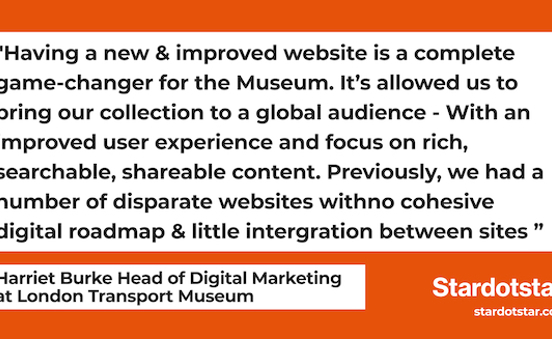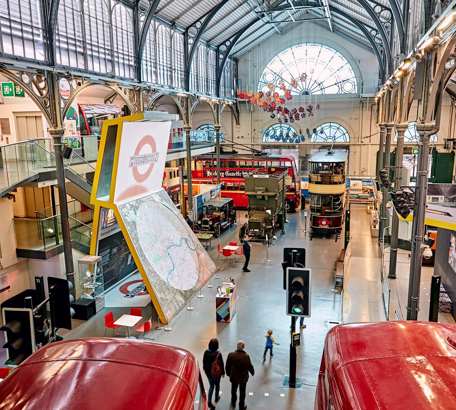
This innovation programme is part of a wider digital transformation going on within the Royal Navy.
London Transport Museum
Market research - consumer, UX and UI, Web design, Web development
London Transport Museum is nestled in the corner of Covent Garden in London and brings together more than 550,000 objects, including locomotives, horse-drawn vehicles, scale models, ticketing and poster art over 120 years. Highlights of the collection include the only surviving steam engine from the 1860s, a double-deck electric tram and an Underground railway pocket map from 1908. The audiences range from families, schools and tourists to historic transport researchers.
BRIEF
What it has in terms of attractions and collections, it certainly wasn't showing to its best extent on its website. The site was difficult to update, rather too busy to be understood easily, and the collections database was incomplete and slow to search. Even core features such as events listing and ticketing were adding frictions for Museum visitors. The LTM team had spent some years' hacking' the constraints of the website, but what the Museum needed and what the old website could do had become distanced. It was creaking at the seems technical and confusing organizationally.
INSIGHT
LTM may not have had the website it needed yet, but what it did have was detailed research and personas — they knew who their visitors were. This gave us the foundation we needed to align the many competing wants of the organisation against the far simper needs of their visitors.
Work started in parallel on three fronts: Researching & Wireframing, Stakeholder Management, and Technical Consultation & Build.
Over three months, we sketched and iterated a series of wireframes to illustrate some hypotheses and assisted the Product Owner at the Museum to understand our methodology — which she did with aplomb. Whilst we lead on researching, making the changes required on our wireframes as we learnt more, the Product Owner helped the Museum understand why those changes were required.
That last bit sounds easy, but it's often the case that helping the internal stakeholders align with a shared vision is one of the core pillars of a successful website. If any senior stakeholder, or group, uses their executive power to give prominence to a particular section of the website, that may lead to unintended consequences and confusion.
Back to Work: We used the personas as a kind of content filter; if the existing website content wasn't applicable to the needs of our users, then it was made secondary or tertiary. Rather than allowing everything to be prioritised equally for internal reasons, we created a hierarchy based on what users need.
This helped us focus on the content and feature hierarchy of the new site and provide the kind of information that museum visitors needed to find fast — backed up by research. Small things like telling potential visitors what time the Museum closes today to see if there's time to travel to it and spend a meaningful amount of time at the Museum with your two children (it's right there, top-left of the browser).
We also realised the inherent value of the Museum's collections database, which had become a bit slow and cumbersome to search. Whilst we worked to find the right UX and design direction, our technical team worked hard to ingest an export of their collections databases and cleanse it to be searchable far more quickly and flexibly. We're told that as a Drupal content type, the collections data could be surfaced within different contexts around the website.
Our wireframes helped bring the Museum stakeholders along on the development journey, helped us visually articulate the Users Experience (ideal for testing) and finally share the features we'd identified for our technical colleagues at CTI to build towards.
OUTCOME
The story behind this project started with how we wireframed, tested, reiterated and focussed what the Museum had, towards what their users needed. There were some large technical challenges with features like Collections, Events Listings and Ticketing — but was it worth it? Let’s see what the Head of Marketing, Harriet Burke thought:

That’s all well and good but what about the numbers?

TWO TAKEAWAYS
A great quote from the client and some eye-popping numbers are always a welcome outcome from how we work — but what two takeaways could you take to improve your work?
1 - Know your users.
The foundations of every project is knowing, really knowing, who your customers, visitors, clients, players or learners are. If you don't have these building blocks, we can help you discover who they are, and what they care about, but that will and should take time.
2 - Bring your people along.
It's often the case that organisations often try to assert that the website information architecture reflects the business itself. There's even a law for it. Stakeholder Management may sound like a form of political manipulation, it's another foundational piece that needs time to bring everyone along on the journey so your people understand why the website is refocussing on users needs.
